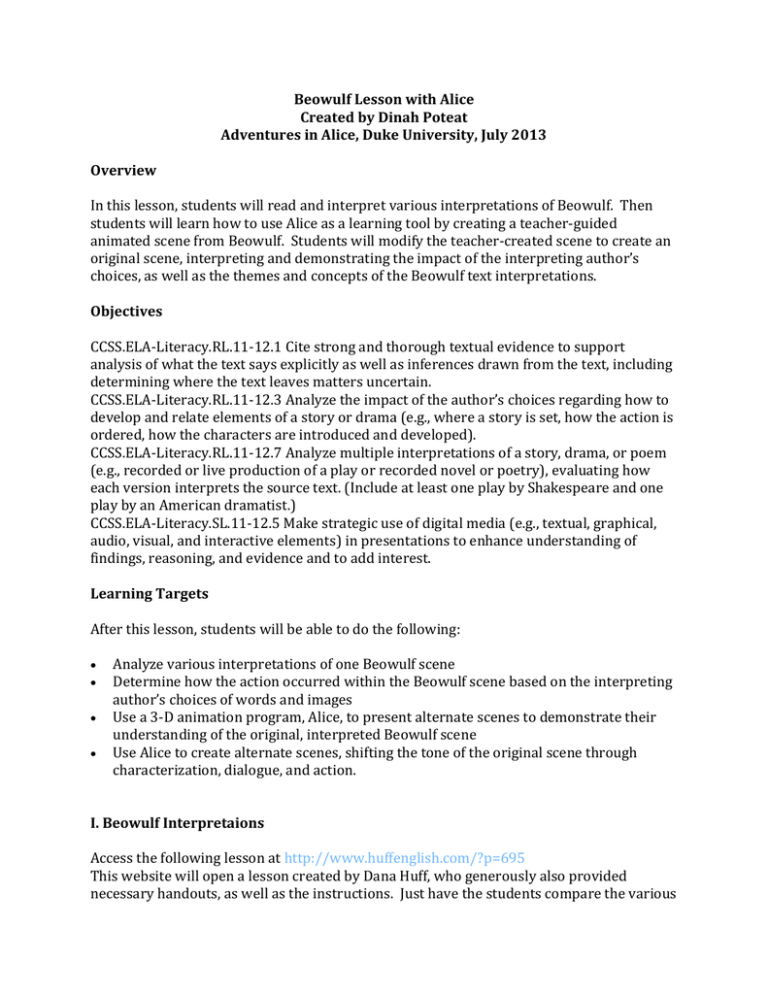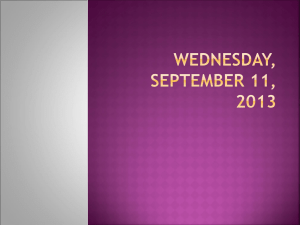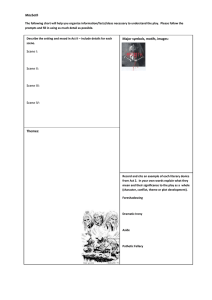Beowulf Lesson with Alice Created by Dinah Poteat Overview
advertisement

Beowulf Lesson with Alice Created by Dinah Poteat Adventures in Alice, Duke University, July 2013 Overview In this lesson, students will read and interpret various interpretations of Beowulf. Then students will learn how to use Alice as a learning tool by creating a teacher-guided animated scene from Beowulf. Students will modify the teacher-created scene to create an original scene, interpreting and demonstrating the impact of the interpreting author’s choices, as well as the themes and concepts of the Beowulf text interpretations. Objectives CCSS.ELA-Literacy.RL.11-12.1 Cite strong and thorough textual evidence to support analysis of what the text says explicitly as well as inferences drawn from the text, including determining where the text leaves matters uncertain. CCSS.ELA-Literacy.RL.11-12.3 Analyze the impact of the author’s choices regarding how to develop and relate elements of a story or drama (e.g., where a story is set, how the action is ordered, how the characters are introduced and developed). CCSS.ELA-Literacy.RL.11-12.7 Analyze multiple interpretations of a story, drama, or poem (e.g., recorded or live production of a play or recorded novel or poetry), evaluating how each version interprets the source text. (Include at least one play by Shakespeare and one play by an American dramatist.) CCSS.ELA-Literacy.SL.11-12.5 Make strategic use of digital media (e.g., textual, graphical, audio, visual, and interactive elements) in presentations to enhance understanding of findings, reasoning, and evidence and to add interest. Learning Targets After this lesson, students will be able to do the following: Analyze various interpretations of one Beowulf scene Determine how the action occurred within the Beowulf scene based on the interpreting author’s choices of words and images Use a 3-D animation program, Alice, to present alternate scenes to demonstrate their understanding of the original, interpreted Beowulf scene Use Alice to create alternate scenes, shifting the tone of the original scene through characterization, dialogue, and action. I. Beowulf Interpretaions Access the following lesson at http://www.huffenglish.com/?p=695 This website will open a lesson created by Dana Huff, who generously also provided necessary handouts, as well as the instructions. Just have the students compare the various translations of Beowulf, as presented by Huff’s handout. Have the students discuss the similarities and differences of the translations. II. Introducing Alice The teacher will introduce Alice to the students by showing the teacher-created example scenes. After viewing the teacher-created example, students will discuss the teacher’s characterization, visualization, dialogue, and action choices. Additional enrichment: discuss the scenes for examples of ethos, pathos, and logos. III. Student-Re-Created Scene The teacher, with the use of the teacher-created PowerPoint, will guide students to complete the teacher-created tutorial of the battle scene (as compared in the translations) . IV. Crafting a lesson Students will modify their created animation scene, altering setting, characters, dialogue, and action, to shift the tone and action of the tutorial-scene creation. Differentiation: Students can “plug-in” their alterations into the already-created scene. Assessment Rubric Requirements Maximum Effort Adequate Effort Minimum Effort No Apparent Effort Original setting 10 9 8 0 Original characters 10 9 8 0 Original dialogue 10 9 8 0 Cohesive story scene Flowing scene components Interesting / exciting ending Extra Credit: Evidence of ethos, pathos, and logos within the scene 30 28 25 0 20 18 15 0 20 18 15 0 15 10 5 0 Points Points Points Points Grade: A




